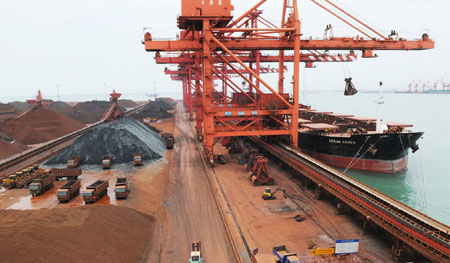Impasse over Iron Ore Continues
Adjust font size:
Before Baosteel, on behalf of China's steel industry, took part in the negotiations with international miners in 2003, Chinese steelmakers were not as concerned about the iron ore prices as today.
|
|
|
Iron ore being unloaded at the Rizhao port in Shandong Province. |
Since 2005, the industry has been arguing that, as the world's largest iron ore importer, China deserves a bigger say in the negotiations with Rio Tinto, BHP Billiton and Vale on annual iron ore pricing. However, iron ore prices jumped over 71 percent in 2005 and by another 70 percent in 2008. This year, Japanese and South Korean firms have accepted a 33 percent cut on last year's price.
Though the China Iron and Steel Association (CISA) is still seeking a "China price", a 40 percent cut in the price of iron ore from Australia, many feel that the industry's weakness has been exposed through the negotiations.
Experts attribute the industry's weak stance in negotiations to the low industrial concentration of the country's steel industry.
In the negotiations, buyers are too scattered, compared with the Big Three suppliers who control over 70 percent of global iron ore trade, said Mei Xinyu, researcher with the Chinese Academy of International Trade and Economic Cooperation, affiliated to the Ministry of Commerce.
"It is tough to form a joint force among buyers of different countries and in China due to the large number of players," he said.
Despite the CISA banning steelmakers from making individual contracts with suppliers, there have been reports of small mills signing agreements with foreign miners.
A number of steel mills in Shanxi province have reportedly signed long-term contracts with foreign miners for this year's iron ore supply last week shortly after 35 Chinese mills signed supply contracts involving 50 million tons of imports with Vale.
Mei added the industry also made some controversial policies, which helped strengthen the buyers' position in talks. Increasing the tax rebates on steel exports has boosted China's demand for iron ore.
The Japanese and South Korean mills can afford a higher price for iron ore imports than Chinese players as many of them own shares in some Australian miners and can still make profit with the 33 percent price cut this year.
Zeng Jiesheng, analyst with Mysteel.com, added sea freight is another key factor affecting the costs of mills because the price agreed between steel mills and suppliers is usually FOB price.
He explained that most Chinese mills lack long-term shipment agreements and are hence exposed to the sea freight price ups-and-downs.
Since the benchmark price was inked by Japanese and South Korean mills last month, sea freight from Brazil and Australia to Chinese ports have increased US$24 and US$5 per ton respectively.
Its influence on steel mills' costs is larger than the around US$6 gap between a 40 percent and 33 percent price cut, Zeng said.
He suggested that Chinese mills must learn from their Japanese rivals who are largely reliant on long-term iron ore supplies but sign annual shipment contracts for them at the same time.
(China Daily June 26, 2009)
